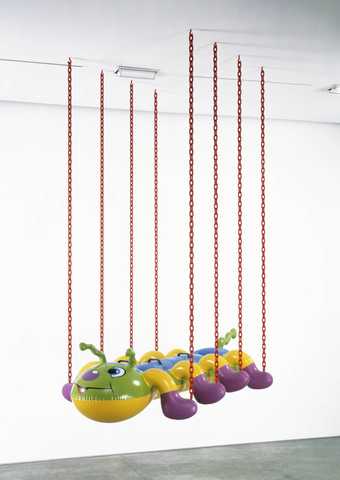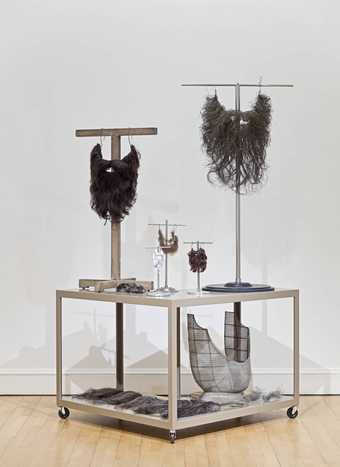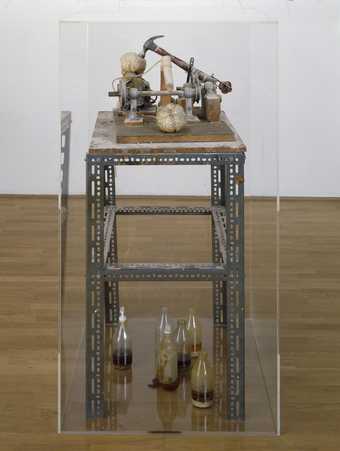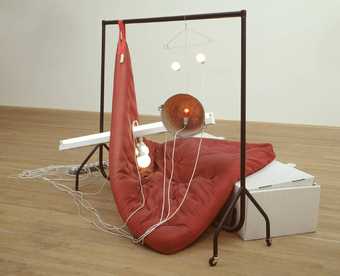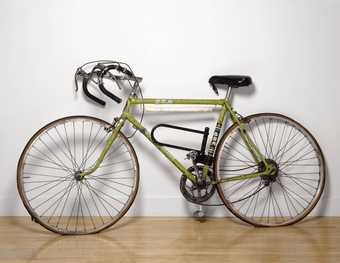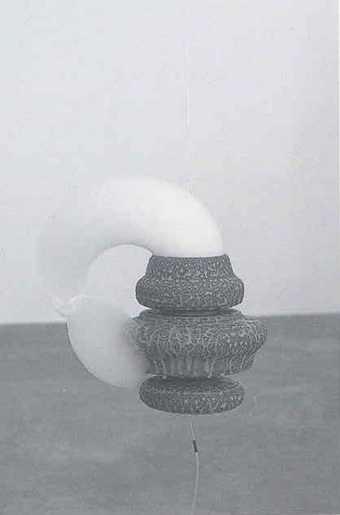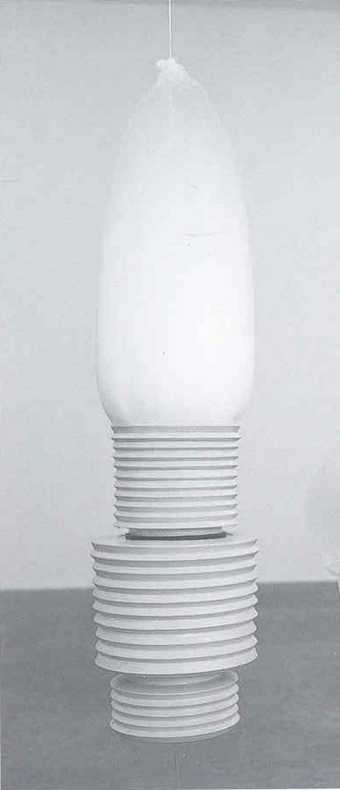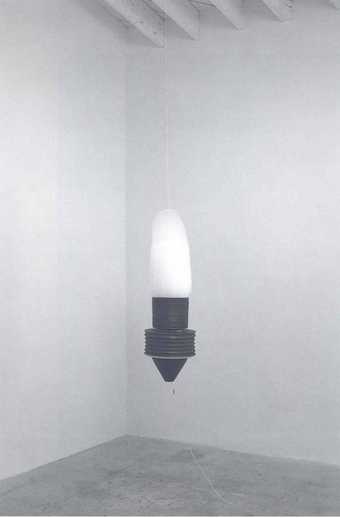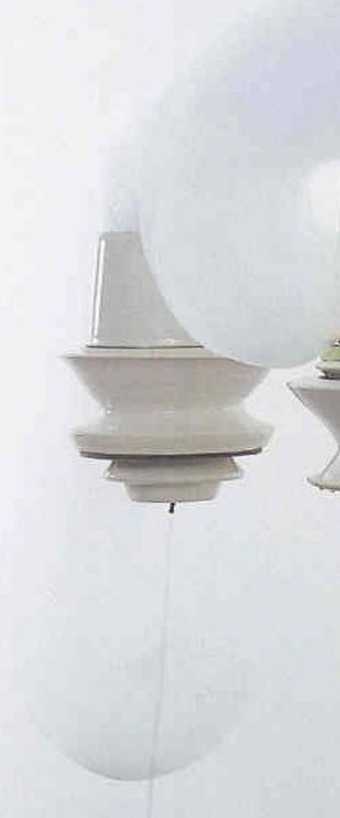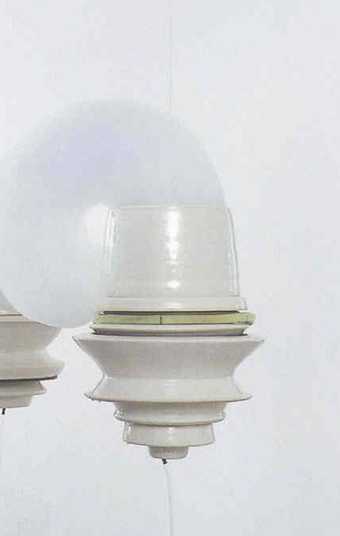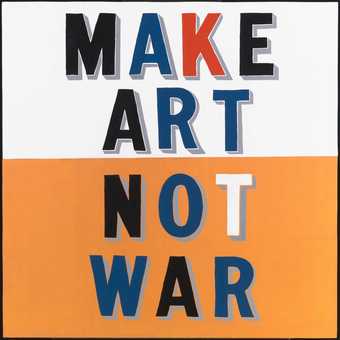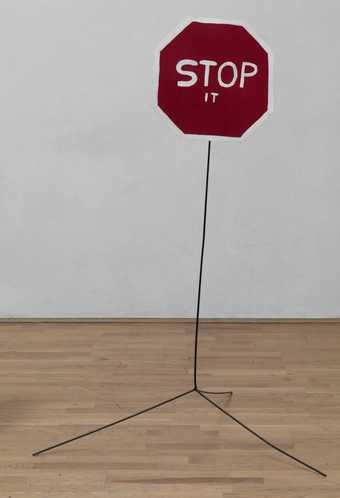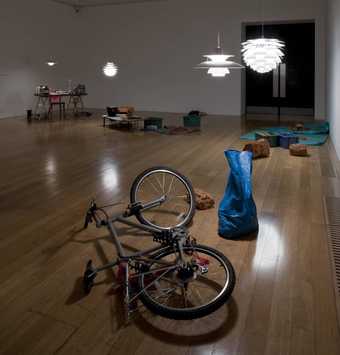Not on display
- Artist
- Simon Starling born 1967
- Medium
- Metal bicycle, steel bars, nylon straps, aluminium buckles, steel brake wires, plastic tubes and rubber padding
- Dimensions
- Object: 1240 × 4050 × 550 mm
- Collection
- Tate
- Acquisition
- Purchased 2004
- Reference
- T11819
Summary
Simon Starling is fascinated by the origins of materials and the processes by which they come to be developed and transformed into things. His works involve historical connections between the activities of discoverers, designers and artists, which he traces back and forth through time, following the processes of things being made from conception to completion. Often this involves travelling to other countries or sourcing and manufacturing materials from obscure and far-away places. His deconstructions and reconstructions of found objects have introduced him to a range of such craft techniques as model-making, lampshade-construction, cabinet-making, metal-work, erecting a log cabin and boat-building. Starling uses these techniques inventively, crossing design areas by taking apart an object like a Charles Eames chair and reforming it into a Marin Sausalito bicycle and vice versa. Starling’s practice combines the tradition of the British explorer – intrepidly venturing into obscure places – with the persona of an eccentric inventor. Such processes as taking apart a wooden boatshed, making a boat from part of it in which he ships the rest of it to another venue where it is reconstructed to form the finished work, Shedboatshed (Mobile Architecture No.2) 2005 (neugerriemschneider, Berlin), encapsulate a kind of poetic logic. Many of Starling’s works develop, through a series of diverse processes, into hand-made versions of design classics and other industrially produced things from the Modernist era. Although they resemble the original objects they usually combine other elements, extending the frame of reference to a wider sphere.
Five-Man Pedersen (Prototype No.1) is such a work, combining Starling’s interest in early design classics with engineering invention. It is based on the famous Dursley-Pedersen bicycle patented and built at the end of the nineteenth century by the Danish inventor Mikael Pedersen (1855-1929) in the Gloucestershire town of Dursley. Around 8000 bicycles were produced until the firm, owned by Pedersen, Robert Asthon Lister and Charles Lister, folded in 1917; the chief innovatory feature being a triangulated design which conferred great structural strength using thin steel tubing, thereby making the bicycle light in weight and easier to manoeuvre. Pedersen based the design on the Whipple-Murphy truss – a double intersection truss used to build railway bridges in the mid-1800s. Starling made Five Man Pedersen, in collaboration with a fabricator in Glasgow (where he lives and works), from parts of twenty vintage bicycles collected from various sources. His plan was to return the bicycle to its original design idea – that of the Whipple-Murphy truss – by extending, through repetition, its basic form so that it became a bicycle that five people could ride. He used an original Pedersen to make the sections of the front and back of his prototype; the original, distinctive sling-like Pedersen leather seat was also used, together with four others sourced from a Danish supplier (in 1978 the Pedersen design was rediscovered and fabrication began anew). The wheels are all second hand. The construction method was improvisatory and experimental, as is usual in the making of prototypes.
Bicycles have featured several times in Starling’s art. In Carbon (Pedersen) 2003 (FRAC Nord Pas de Calais), he adapted two Pedersens (designed circa 1896) so that they could be powered by chainsaws. The bikes may also be dismantled to create a survival kit comprising two stools, a tent and a cooking spit, freeing up the chainsaws for cutting wood. For Tabernas Desert Run 2004 he adapted a racing bicycle so that it ran on electricity powered by hydrogen and oxygen. In a homage to American performance artist Chris Burden’s Death Valley Run 1977, in which he drove across Death Valley on an underpowered motorbike, Starling crossed the Tabernas Desert in southern Spain on his improvised electric bicycle. Starling’s use of bicycles quotes a well known work by Marcel Duchamp (1887-1968), whose Bicycle Wheel 1913/51 (Museum of Modern Art, New York), comprising a metal wheel mounted on a wooden stool, presents these humble, functional ready-mades as art (making an ironic comment on man’s progress through invention – the wheel being one of the earliest means to progress). In a nod to Duchamp, Starling photographed a bicycle wheel from the Five-Man Pedersen which had buckled on a test run, titling the palladium print Bicycle Wheel (Failed) 2003/4.
Further reading:
The Hugo Boss Prize 2004, exhibition catalogue, Solomon R. Guggenheim Museum, New York 2004, pp.53-63
Simon Starling: Cuttings, exhibition catalogue, Kunstmuseum Basel and The Power Plant, Toronto 2005, pp.B2-3, B20-1 and B78-9
Simon Starling: Djungel, exhibition catalogue, Dundee Contemporary Arts, 2002
Elizabeth Manchester
October 2005
Does this text contain inaccurate information or language that you feel we should improve or change? We would like to hear from you.
Technique and condition
The following entry is based on an interview with Simon Starling at Tate Store on 14th October 2005 as well as documentation from the conservation record held in Sculpture Conservation.
A single unit made up of parts taken from twenty different bicycles that the artist collected and a Pederson (the black sections at the front and back). The longer new steel bars were made specially and the thin grey tubes were obtained specifically from bicycles in Berlin. The bicycle should be in working order.
Comprising iron, steel, aluminium, paint, leather, glass, rubber, nylon and plastic, the frames of the different bicycles have been welded together. The seats are suspended on nylon straps with aluminium buckles which incorporate four metal springs under each seat. There is abraded and burned paint next to the welded joints of the frame; this is a result of the manufacture process and the artist wishes this to remain. The inscriptions in white paint on the black Pederson parts (PATT No.s 2-7) indicate how the original Pederson had to be cut up and reconfigured during construction.
Upon acquisition, the work was structurally in good condition. All the welded joints are structurally strong. Rust is present on various metal elements and there is also a rusty screw on the back fender. The front fender is dented. The various bicycle parts had already aged before the work was constructed and the artist noted in the interview of October 2005 that he is happy with the work in its current condition. The work should be dusted before and during display if necessary and grease should be left to ensure that the Pederson remains in working order.
For display, the work should be lent against a wall, resting on the handle bars. The tyres should be pumped up and then deflated for transportation or storage.
Bryony Bery
October 2005
Explore
- emotions, concepts and ideas(16,416)
-
- universal concepts(6,387)
-
- humour(1,441)
- transport: land(2,189)
-
- bicycle(196)
You might like
-
Jeff Koons Caterpillar (with chains)
2002 -
Robert Therrien No Title (Beard Cart)
2004 -
Marc Quinn No Visible Means of Escape IV
1996 -
Jake Chapman, Dinos Chapman Little Death Machine (Castrated)
1993 -
Sarah Lucas Beyond the Pleasure Principle (Freud)
2000 -
Elizabeth Wright B.S.A. Tour of Britain Racer Enlarged to 135%
1996–7 -
Roger Hiorns Untitled
2003 -
Roger Hiorns Untitled
2003 -
Roger Hiorns Untitled
2005 -
Roger Hiorns Untitled
2005 -
Roger Hiorns Untitled
2005 -
Roger Hiorns Untitled
2005 -
Bob and Roberta Smith Make Art Not War
1997 -
David Shrigley OBE Stop It
2007 -
Simon Starling Work Made-ready, Les Baux de Provence (Mountain Bike)
2001


